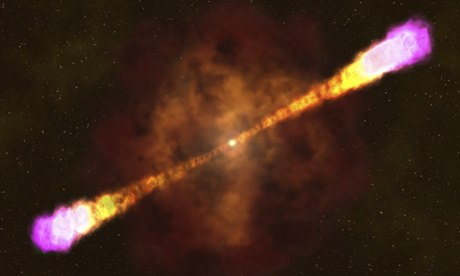 |
|
Image
provided by Nasa's Goddard Space Flight Centre shows an
artist's
rendering of how a gamma ray burst occurs. Photograph: AP
|
Associated
Press
The
Guardian - 22 November 2013
Astronomers
call it the monster. It was the biggest and brightest cosmic explosion ever
witnessed. Had it been closer, Earth would have been toast.
Because
the blast was 3.7bn light years away, mankind was spared. But orbiting
telescopes got the fireworks show of a lifetime in April.
The only
bigger display astronomers know of was the big bang that created the universe,
and no one was around to see that.
The blast
was a gamma ray burst, an explosion that happens when a massive star dies,
collapses into a brand-new black hole, creates a supernova and ejects energetic
radiation that is as bright as can be as it travels across the universe at the
speed of light.
Nasa
telescopes in orbit have been seeing these types of bursts for more than 20
years, spotting one every couple of days. But this one was special. It set
records, according to four studies published on Thursday in the journal
Science.
It
flooded Nasa instruments with five times the energy of its nearest competitor,
a blast in 1999, said University of Alabama at Huntsville astrophysicist Rob
Preece, author of one of the studies.
It started
with a star that has 20 to 30 times the mass of our sun, but is only a couple
of times bigger in width, so it is incredibly dense.
In
general, gamma ray bursts are "the most titanic explosions in the
universe" and this one was so big some of the telescope instruments hit
their peak, Preece said. It was far stronger and lasted longer than previous
ones.
"I
call it the monster," Preece said. And he wasn't alone. One of the other
studies, not written by Preece, used the word "monster" in its title,
unusual language for a scientific report.
One of
the main reasons this was so bright was that relative to the thousands of other
gamma ray bursts astronomers have seen, the monster was pretty close, even at
3.7bn light years. A light year is almost 6 trillion miles.
Most of
the bursts Nasa telescopes have seen have been twice as distant as this one.
Other explosions could be this big, but are so much farther away they don't
seem so bright when they get to Earth, the studies' authors say.
Astronomers
say it is incredibly unlikely that a gamma ray burst – especially a big one
like this – could go off in our galaxy, near us. Harvard's Avi Loeb, who wasn't
part of the studies, put the odds at at least 1 in 10 million.
Also, a
burst has to be pointing at you to be seen and to be dangerous. It's
concentrated like a focused searchlight or death beam. Planets caught in one
would lose their atmospheres instantly and would be left a burnt cinder,
astronomers say.
"Either
it's pointed at us or it's not," Preece said. "If it's not, yay!
Civilisation survives and we see maybe a supernova. If it were pointed at us,
then it matters very much how far away it is in our galaxy. If it's in our
local arm, well, we had a good run."
We don't
see gamma ray bursts on the surface of Earth because the atmosphere obscures
them and because their light is the type we cannot see with our eyes, but Nasa
has satellites that look for them.
For
scientists who look for gamma ray bursts, this was an extraordinary moment.
"These
are really neat explosions," said Peter Michelson, a Stanford physicist
who is the chief scientist for one of the instruments on a Nasa gamma ray
burst-spotting telescope. "If you like fireworks, you can't beat these.
Other than the big bang itself, these are the biggest there are."
The burst
"is part of the cycle of birth and life and death in the universe",
Michelson said. "You and I are made of the stuff that came from a
supernova."
No comments:
Post a Comment